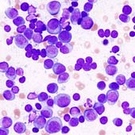Articles tagged with: Background Information
Resources»

Multiple myeloma (also called myeloma or plasma cell myeloma) is a cancer of the plasma cells. Plasma cells are an important component of the immune system and are typically found in the bone marrow.
When functioning properly, plasma cells produce a variety of infection-fighting proteins called antibodies, or immunoglobulins. When a person has multiple myeloma, however, their plasma cells begin overproducing one type of abnormal antibody. This antibody is referred to as a monoclonal (M) protein. Monoclonal proteins cannot effectively fight infections. In addition, the growth of myeloma cells may inhibit the …
Resources»

The American Cancer Society estimated that in 2009, 20,580 people in the United States will be diagnosed with multiple myeloma. The lifetime risk for developing multiple myeloma is 1 in 161, or 0.62 percent.
Although scientists and doctors do not know the exact causes of multiple myeloma, doctors do know some risk factors that make people more likely to develop multiple myeloma. However, many people who have more than one of these identified risk factors do not get the disease, and many people who get the disease do not display all these …
Resources»

Overview
Multiple myeloma, like most medical conditions, manifests itself slightly differently in each patient. Because multiple myeloma can affect many organs, several possible symptoms exist, and they vary greatly. No sign or symptom is a direct indicator of multiple myeloma. Any symptom may be due to other causes, and multiple myeloma may initially cause no symptoms at all.
Multiple myeloma occurs when cancerous myeloma cells collect in many bones, unlike a plasmacytoma, which only involves a solid tumor in one bone. Symptoms typically begin to develop when myeloma cells start to crowd …
Resources»

There is not a single test or medical procedure that can accurately diagnose a patient for multiple myeloma. Instead, multiple factors are considered before a diagnosis is made. Please review the sections below for more information on these specific factors.
Blood Test
Blood tests show the components of the blood. When a person has myeloma, specific blood cells and proteins, which are identified through a test called protein electrophoresis, are present in excess amounts in the blood. For example, a myeloma patient’s blood test might show high levels of plasma cells, calcium …
Resources»

Currently, there are many treatments that slow down the progression of multiple myeloma, reduce tumors, and relieve pain and other symptoms. Clinical trials are also available at every stage of treatment.
Multiple myeloma treatments are tailored to patients’ age, general health, lifestyle, goals for treatment, response to any previous treatments, the disease’s stage, and whether the disease is active or inactive.
Smoldering multiple myeloma, also called inactive or asymptomatic multiple myeloma, is a stable form of myeloma where the affected person does not feel any symptoms. In this case, the person may …
Resources»

Any person’s individual multiple myeloma prognosis depends on several health factors. People who have kidney damage or who are older are more likely to have poorer prognoses. Additionally, doctors perform many tests to get an overall picture of how a person’s body is responding to myeloma.
Samples of a person’s bone marrow can be tested for different factors that affect prognoses. A lab test called the myeloma cell staging index or plasma cell labeling index can show the percentage of myeloma cells that are growing, with lower labeling indexes indicating a better …

